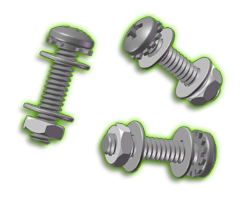

 |

|
IPC-7351 Mounting Hole Naming Convention & Info |
Post Reply 
|
Page 12> |
| Author | ||
Tom H 
Admin Group 

Joined: 05 Jan 2012 Location: San Diego, CA Status: Offline Points: 5814 |
 Post Options Post Options
 Thanks(0) Thanks(0)
 Quote Quote  Reply Reply
 Topic: IPC-7351 Mounting Hole Naming Convention & Info Topic: IPC-7351 Mounting Hole Naming Convention & InfoPosted: 13 Feb 2013 at 1:31pm |
|
|
Let's break it down like IPC would -
MTG - component family P - Plated + pad Size - value in millimeters (2 places to each side of decimal point and drop leading zero's) NP - Non-plated + pad Size - value in millimeters (2 places to each side of decimal point and drop leading zero's) H + hole size - value in millimeters K + keepout size - value in millimeters (this normally maps to the placement courtyard diameter) V + Number of vias _ via hole size (this is a modifier and not necessary when there are no vias) T - Tight Fit L - Loose Fit Example: MTGNP1000H360K1050L We need to think of all the options and how they need to be arranged. |
||
 |
||
 |
||
JZsori 
Advanced User 
Joined: 01 Mar 2012 Status: Offline Points: 65 |
 Post Options Post Options
 Thanks(0) Thanks(0)
 Quote Quote  Reply Reply
 Posted: 13 Feb 2013 at 2:08pm Posted: 13 Feb 2013 at 2:08pm |
|
|
OK - but in my case I will likely simplify it some. My placement courtyard will be slightly larger than the pad size. I will put in actual keepout areas as mine is a little more complicated in that I have different keepout areas for primary and secondary sides.
|
||
 |
||
Tom H 
Admin Group 

Joined: 05 Jan 2012 Location: San Diego, CA Status: Offline Points: 5814 |
 Post Options Post Options
 Thanks(0) Thanks(0)
 Quote Quote  Reply Reply
 Posted: 13 Feb 2013 at 2:39pm Posted: 13 Feb 2013 at 2:39pm |
|
|
Don't forget that all non-plated mounting holes still need a pad to support the hardware:
 Here is a Mounting Hole with a Keepout:  Here is Mounting Hole with sattelite support vias. The vias are usually connected to the ground plane.  Here is a Non-plated hole example:  |
||
 |
||
Dale 
Active User 
Joined: 04 Mar 2012 Location: Australia Status: Offline Points: 15 |
 Post Options Post Options
 Thanks(0) Thanks(0)
 Quote Quote  Reply Reply
 Posted: 13 Feb 2013 at 3:20pm Posted: 13 Feb 2013 at 3:20pm |
|
|
Tom, in your last image you show a copper-free annulus between pad and hole.
However I consider a non-plated mounting hole as analogous to every hole on a single-sided board - and we don't provide a copper-free annulus on those. Can you educate me/us on the differences? Thanks. |
||
 |
||
Tom H 
Admin Group 

Joined: 05 Jan 2012 Location: San Diego, CA Status: Offline Points: 5814 |
 Post Options Post Options
 Thanks(0) Thanks(0)
 Quote Quote  Reply Reply
 Posted: 13 Feb 2013 at 3:25pm Posted: 13 Feb 2013 at 3:25pm |
|
|
The non-plated hole drill bit cannot hit any copper (metal), just a clean hole through the FR4 material.
The mfr. desmears plated holes, but non-plated holes are plugged or masked during the plating process. IPC has a rule on this and I think it's in the newly released IPC-2221B standard (which I don't have yet, but I'll get it at APEX next week. |
||
 |
||
JZsori 
Advanced User 
Joined: 01 Mar 2012 Status: Offline Points: 65 |
 Post Options Post Options
 Thanks(0) Thanks(0)
 Quote Quote  Reply Reply
 Posted: 13 Feb 2013 at 3:28pm Posted: 13 Feb 2013 at 3:28pm |
|
|
My understanding is that it is preferable to have a donut pad for the screw head so that the screw does not crush the epoxy glass material as much as it has a copper pad in between.
|
||
 |
||
Dale 
Active User 
Joined: 04 Mar 2012 Location: Australia Status: Offline Points: 15 |
 Post Options Post Options
 Thanks(0) Thanks(0)
 Quote Quote  Reply Reply
 Posted: 13 Feb 2013 at 4:56pm Posted: 13 Feb 2013 at 4:56pm |
|
But why? The plated hole drill bit hits copper on every hole.
The copper pad might help distribute the force, but I don't see how this has anything to do with keeping the copper away from the hole. |
||
 |
||
Tom H 
Admin Group 

Joined: 05 Jan 2012 Location: San Diego, CA Status: Offline Points: 5814 |
 Post Options Post Options
 Thanks(0) Thanks(0)
 Quote Quote  Reply Reply
 Posted: 13 Feb 2013 at 6:22pm Posted: 13 Feb 2013 at 6:22pm |
|
|
Both statements are correct.
1. Donut Pad so that the pad center is pulled away from the drill bit so the drill does not go through metal to avoid metal fragments and produce a clean hole. Like I mentioned, there is an excellent reason and description of the non-plated mounting hole in the newly released IPC-2221B. 2. The Donut Pad acts as mechanical support during the torque process when tightening the screw to the board to prevent the FR4 glass from crushing. i.e.: It's best to have metal on metal and avoid having the screw hardware make any contact with the FR4 material. |
||
 |
||
Dale 
Active User 
Joined: 04 Mar 2012 Location: Australia Status: Offline Points: 15 |
 Post Options Post Options
 Thanks(0) Thanks(0)
 Quote Quote  Reply Reply
 Posted: 13 Feb 2013 at 6:40pm Posted: 13 Feb 2013 at 6:40pm |
|
|
||
 |
||
jameshead 
Expert User 
Joined: 20 Mar 2012 Location: Oxfordshire, UK Status: Offline Points: 576 |
 Post Options Post Options
 Thanks(0) Thanks(0)
 Quote Quote  Reply Reply
 Posted: 14 Feb 2013 at 2:19am Posted: 14 Feb 2013 at 2:19am |
|
|
In addition to Tom's two points:
A non-plated hole can have copper around it but it affects the fabrication of the board. If a non-plated hole is clear of copper then it can be drilled at the first stage drilling along with all the plated holes and is then "tented" by the film to prevent it being plated. If you have a non-plated hole with the drill going through copper then as well as the points Tom mentions, the drill will have to be drilled at the second stage drilling along with the route. |
||
 |
||
Post Reply 
|
Page 12> |
| Tweet |
| Forum Jump | Forum Permissions  You cannot post new topics in this forum You cannot reply to topics in this forum You cannot delete your posts in this forum You cannot edit your posts in this forum You cannot create polls in this forum You cannot vote in polls in this forum |